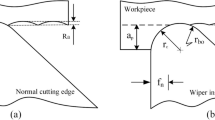Abstract
Compacted graphite cast iron (CGI) has been the material for high-power diesel engines recently, but its increased strength causes poor machinability. In this study, coated and uncoated carbide tools were used in dry milling experiment and FEM simulation to study the machinability of CGI and wear behaviour of tools. The experimental and FEM simulation results show that coated tool has great advantage in dry milling of CGI. SEM and EDS analysis of tool wear indicate the wear morphology and wear mechanism. Adhesive wear is the main mechanism to cause uncoated tool wear, while abrasive wear and delamination wear are the main mechanism to cause coated tool wear. Stress and temperature distribution in FEM simulation help to understand the wear mechanism including the reason for coating peeled off.
Similar content being viewed by others
References
Callister W D. Materials Science and Engineering: An Introduction[M]. Wiley, USA, 2007.
Dawson S, Schroeder T. Practical applications for compacted graphite iron[J]. American Foundry Society Transactions, 2004, 47(5): 1–9.
Guesser W L. Compacted graphite iron: A new material for diesel engine cylinder blocks[C]. In: Schmidt R A. II Encontro da SBPMat Brazilian MRS Meeting. Brazil, 2003.
Kalpakjian S, Schmid S R. Manufacturing Engineering & Technology[M]. 6th Edition. Prentice Hall, USA, 2009.
Lu Jianlin. The Study of the Infection of Cutting Usage to Tool Durability in Machining Compacted Graphite Iron[D]. School of Mechanical Engineering, Shanghai Jiao Tong University, Shanghai, China, 2009 (in Chinese).
Heck M, Ortner H M, Flege S et al. Analytical investiga tions concerning the wear behaviour of cutting tools used for machining of compacted graphite iron and grey cast iron[J]. Refractory Metals and Hard Materials, 2008, 26(1): 197–206.
Abele E, Sahm A, Schulz H. Wear mechanism when machining compacted graphite iron[J]. CIRP Annals — Manufacturing Technology, 2002, 51(1): 53–56.
Skvarenina S, Shin Y C. Laser-assisted machining of compacted graphite iron[J]. International Journal of Machine Tools & Manufacture, 2006, 46(1): 7–17.
Grzesik W, Rech J, Zak K et al. Machining performance of pearlitic-ferritic nodular cast iron with coated carbide and silicon nitride ceramic tools[J]. International Journal of Machine Tools & Manufacture, 2009, 49(1): 125–133.
Jindal P C, Santhanam A T, Schleinkofer U et al. Performance of PVD TiN, TiCN, and TiAlN coated cemented carbide tools in turning[J]. International Journal of Refractory Metals & Hard Materials, 1999, 17(1/2/3): 163–170.
Yigit R, Celik E, Findik F et al. Tool life performance of multilayer hard coatings produced by HTCVD for machining of nodular cast iron[J]. International Journal of Refractory Metals & Hard Materials, 2008, 26(6): 514–524.
Sun Guoyuan, Liu Chaofeng, Yang Li. Composite tools and coating tools for cutting casting iron[J]. Foundry Technology, 2009, 30(9): 1188–1191(in Chinese).
International Organization for Standardization. ISO 8688-1-1989 Tool Life Testing in Milling, Part 1[S]. Switzerland, Technical Committee ISO/TC, 1989.
Yu Yipeng. Simulation Research of Metal Cutting Process by Finite Element Method[D]. School of Mechanical Engineering, Dalian University of Technology, Dalian, China, 2005 (in Chinese).
Majumdar P, Jayaramachandran R, Ganesan S. Finite element analysis of temperature rise in metal cutting processes[J]. Applied Thermal Engineering, 2005, 25(14): 2152–2168.
Zhang D J, Wan C, Liu G et al. A FEM and experiment study on high speed machining of nickel-based superalloy GH4169[J]. Key Engineering Materials, 2008, 375/376: 82–86.
Author information
Authors and Affiliations
Corresponding author
Additional information
Supported by National Natural Science Foundation of China (No. 50935001 and No. U0734007), Important National Science and Technology Specific Projects of China (No.,20011ZX04015-031), National High Technology Research and Development Program of China(“863”Program, No. 2009AA04Z150)and Major State Basic Research Development Program of China (“973” Program, No. 2010CB731703 and No. 2011CB706804).
CHEN Ming, born in 1966, male, Dr, Prof.
Rights and permissions
About this article
Cite this article
Chen, M., Jiang, L., Guo, G. et al. Experimental and FEM study of coated and uncoated tools used for dry milling of compacted graphite cast iron. Trans. Tianjin Univ. 17, 235–241 (2011). https://doi.org/10.1007/s12209-011-1609-1
Accepted:
Published:
Issue Date:
DOI: https://doi.org/10.1007/s12209-011-1609-1



